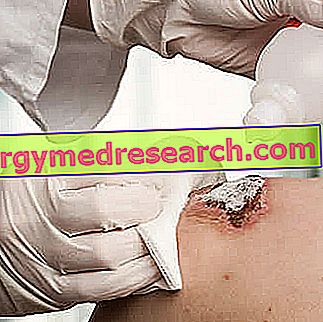Health risks
In general, if used correctly, contact lenses are quite safe. Any complications related to their use are quite rare and affect about 5% of users every year.

The phenomena of intolerance and any complications can determine the onset of disorders typical of contact lens wearers or amplify pre-existing eye diseases. The long list of problems that can occur ranges from minor discomfort to vision loss, the outcome of a serious infection or corneal ulceration.
According to some medical statistics, about 80% of contact lens wearers are not aware of the risks associated with device wear and improper cleaning. It is a good rule to wear contact lenses for a limited time, always follow the instructions provided by the ophthalmologist for proper maintenance and schedule routine checks.
Predisposing factors
A small percentage of patients are not eligible for use of these devices due to individual hypersensitivity or complex optical requirements. Knowing the causes of reduced tolerance to the use of contact lenses is important to prevent more serious complications.
Improper use of contact lenses can negatively affect the eyelid, conjunctiva and various layers of the cornea. The most important risks are associated with the reduced supply of oxygen, necessary to satisfy the needs of the corneal surface; normally, the cornea gets it from tears and from the surrounding environment during wakefulness, and from the blood vessels located at the back of the eyelid during rest. Contact lenses are a barrier to oxygen and wearing them for a prolonged period of time can produce effects such as blurred vision, pain and eye redness. This is why much research is focused on improving the materials they are made of.
The way in which contact lenses interact with the natural tear layer is also an important factor in determining device comfort and visual clarity. People who suffer from dry eyes are particularly vulnerable to discomfort and brief episodes of blurred vision. The dry eye can also be aggravated by concomitant factors, such as smoking, dust, air conditioning and drugs (for example: antihistamines, diuretics and psychotropic agents). For some patients, the correct choice of contact lens can minimize these effects.
Factors that contribute to developing a complication related to the use of contact lenses include:
- Patient fitness (local or general);
- Dry eye and reduced tear exchange under the lens (narrow lens syndrome);
- Infections (example: blepharitis, conjunctivitis, etc.);
- Allergic complications;
- Poor hygiene, such as incorrect maintenance and re-use (or refilling) of the contact lens solution;
- Excessive use;
- Sleep with lenses not approved for prolonged use;
- Environmental harmful factors;
- Systemic diseases;
- Trauma or surgery.
Contact lens wearers who experience pain, blurred vision, irritation or excessive watery eyes should arouse a high degree of suspicion about the presence of possible slow-related complications, which is why their use should be stopped pending investigations.
Proper handling, storage and cleaning of contact lenses are essential steps to reduce the risk of an infection.
Major complications caused by contact lenses
The problems caused by the use of contact lenses can be:
- Associated with the contact lens;
- Associated with conjunctive conditions;
- Associated with corneal problems.
Problems due to the lens
Inadequate contact lens size
If the contact lenses are narrow or inadequate in size they can cause damage to the ocular surface. Typically, narrow contact lenses are initially comfortable, but are associated with increasing discomfort over a period of several hours; with continued use, tight lens syndrome can lead to corneal problems. A contact lens that is too mobile, on the other hand, determines the decentralization of the device, which causes an alteration of the vision with each blink. Rigid contact lenses, which do not fit properly, can cause corneal abrasions. These injuries can increase the chances of bacterial adhesion; consequently, species In combination with improper contact lens cleaning, the risk of developing an infection increases.
Poor cleaning of the contact lens
Failure to clean favors the accumulation of proteins and lipid deposits on the lens, which can cause corneal irritation and visual impairment. Bacteria and protozoa can form a film on the surface of the device, while the fungal filaments can invade the lens itself. Deposits or damage may also occur due to direct contact with other substances, such as hair sprays, make-up, smoke or hand creams.
Lens damage
Damage may occur in the form of scratches or breaks, especially if excessive pressure is applied to the device during the cleaning process or if it has been stored at too high temperatures (for example, rinsing in hot water or keeping the lenses on the dashboard car). A damaged contact lens can cause difficulty in correcting a refractive error, local irritation and corneal deformation. Furthermore, damaged contact lenses are more at risk of colonization by pathogens, which can determine the onset of conjunctivitis or keratitis. Deterioration is more common with soft contact lenses than with rigid gas-permeable lenses (RGP).
Contact lens drying
A reduced frequency of winks is common in contact lens wearers. This can cause or aggravate the drying of the device and give rise to corneal hypoxia.
Conjunctival problems
Allergic conjunctivitis
The reaction is mainly due to sensitivity to thiomersal, a preservative used in solutions for maintaining contact lenses. The effect is worse immediately after application and is reduced over time; it manifests itself with redness, burning and itching. Diagnosis is difficult and allergic conjunctivitis may also appear gradually days or months after initial exposure.
Giant-papillary conjunctivitis
The condition, mediated by mechanical and immune factors, manifests itself with the appearance of large papillae (> 3.0 mm) in the upper tarsal conjunctiva. The giant-papillary conjunctivitis is a direct consequence of the intolerance to the use of the contact lens and presents itself with irritation and redness of the eyes. The treatment consists in removing the device until the condition is completely resolved. Topical mast cell stabilizers (such as sodium chromoglycate) may be used, but should not be instilled during the application of soft contact lenses.
Upper limbic idiopathic keratoconjunctivitis. The disorder occurs especially in contact lens wearers with a hydrogel base, in women between the ages of 20 and 60 and, in particular, in the case of altered thyroid function (in about 30-50% of cases). Upper limbic idiopathic keratoconjunctivitis occurs, once again, with lens intolerance, redness and irritation of the eye.
Toxic conjunctivitis
The condition can occur as a reaction to the cleaning solutions used for cleaning the contact lenses, due to the absorption of the preservatives contained in them. The devices can also react with other substances present on the wearer's hand at the time of application (for example perfume or hand cream). This problem occurs especially when using soft contact lenses. The eye turns red and corneal abrasions can develop. Once again, the treatment consists in removing the contact lens until the condition is completely resolved. If toxic conjunctivitis occurs in severe form, a short course of topical steroids may be prescribed, in combination with lubricants.
Corneal problems
Punctual superficial keratitis
Pointed superficial keratitis is the problem most commonly associated with the use of worn contact lenses. At diagnosis, when the anterior surface of the eye is evaluated with a slit lamp equipped with cobalt blue light, the condition is identified in the lower half of the cornea thanks to the appearance of small scattered dots, colored with fluorescein. Pointed superficial keratitis may also occur in association with any of the conditions described below.
Mechanical damage
Mechanical damage of the cornea can occur in case of breakage or damage to the contact lens, due to trauma during insertion or removal operations or to the friction caused by debris accumulated on the surface of the device.
Narrow lens syndrome
An incorrect measuring lens does not allow adequate oxygenation of the ocular surface with each blink. Narrow lens syndrome manifests with generalized corneal edema, epithelial erosions and neovascularization. The condition is aggravated by the reduction in blinking, the use of rigid contact lenses and the failure to remove the device overnight. The narrow lens syndrome can induce the onset of consequences such as inadequate closure of the eyelids, excessive tearing and localized drying of the cornea. The condition can be alleviated by using the lens in combination with topical (compatible) lubricants.
Corneal hypoxia
The condition is manifested by the decreased diffusion of oxygen through the lens. Currently, this is rare, thanks to the quality of modern contact lenses; however, it can still occur when people do not replace them or use them beyond the recommended time. In the acute phase, corneal hypoxia can produce corneal ulceration and pain. Chronic disorder can be asymptomatic, but result in alterations in the structure of the cornea and neovascularization. This last characteristic is more frequent in hydrogel-based lens wearers, but can also occur with RGPs. Superficial neovascularization (1-2 mm) can be monitored without treatment, but deeper growth can cause intracorneal bleeding and visual disturbances. The eventual treatment consists in the removal of the contact lens and in the management of the corneal ulcer with antibiotics and topical steroids.
Infiltrative keratitis
The condition is the result of an excessively long use of the contact lens. Infiltrative keratitis manifests itself with reddening of the eyes with acute onset (sudden). The treatment consists in removing the contact lens until complete resolution.
Microbial keratitis
Microbial keratitis is the most serious and common complication associated with the use of contact lenses and can result in altered vision. The patient has pain, profuse tearing or eye discharge, irritation, photophobia and redness of the eyes. Microbial keratitis is more common in people with soft lenses; the infection is commonly caused by Pseudomonas spp. and Klebsiella spp., although other bacteria and fungi can produce the disease. In particular, the organism Acanthamoeba spp. it can cause a rare, but potentially devastating, disease, dangerous to the eye (it can cause a breakdown of the corneal tissue). Acanthamoeba keratitis may initially present as a dendritic ulcer and may be misdiagnosed as Herpes simplex infection. Patients should be treated urgently, via antibiotics and hospitalization. Contact lenses and cleaning solution should be placed in microbiological culture, along with the sample that comes from corneal scraping. Infection with Acanthamoeba spp. requires a specialized treatment, with a combination of anti-amoeba agents. Corneal scars represent a common complication and some patients require a corneal transplant.
It is important to remember that corneal neovascularization and microbial keratitis can cause permanent damage or even blindness, if not treated quickly and adequately.
Viral infections
Herpesvirus or Adenovirus infections can occur during contact lens wear, especially if worn during an active viral infection.
Contact lenses and drugs
Topical drugs
- As a general rule, it is best not to wear contact lenses when topical ocular treatment is needed.
- The use of ocular preparations, in the form of ointment, is incompatible with any type of contact lens.
- Rigid contact lenses can be worn with certain types of eye drops, to be instilled over the device.
- Soft contact lenses can be applied only if drops are used without preservatives (in particular, look for the presence of benzalkonium chloride in the ingredients). Some of these, in fact, accumulate in the hydrogel lenses and can induce toxic reactions.
Systemic drugs
Some systemic drugs can interact with contact lenses in different ways. In any case, it is advisable to always check the interactions and side effects. Some examples are provided below.
| Effect of the drug | Examples |
Increase in deposit on the contact lens | Oral contraceptives, disopyramide and chlorpromazine. |
Discoloration of the contact lens | Rifampicin, sulfasalazine and tetracycline. |
Corneal edema | Oral contraceptives, digoxin and primidone. |
Reduced wink | Anxiolytics, hypnotics, antihistamines and muscle relaxants. |
Reduced tearing | Oral contraceptives, antihistamines, antimuscarinics, phenothiazines, some beta-blockers, diuretics and tricyclic antidepressants. |
Increased tearing | Ephedrine and hydralazine. |
Inflammation of the conjunctiva | Isotretinoin and salicylic acid. |
Practical rule
Whenever you use contact lenses it is important to ask yourself:- Do your eyes feel any kind of discomfort?
- Do the eyes show an abnormal reaction (such as redness or burning)?
- Is the vision altered by an unusual blur in one or both eyes?
A positive response to one of these questions should prompt the immediate removal of the contact lens and the medical evaluation of a possible complication.



